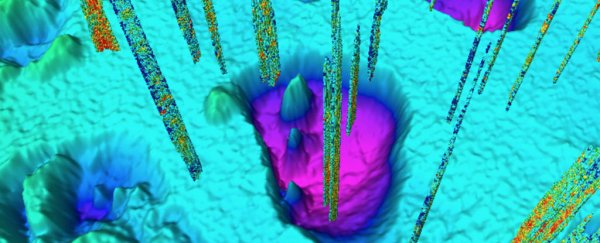Researchers monitoring a number of massive frozen domes of methane in the Arctic Ocean say there are signs that a series of blowouts could be imminent.
The effect would be reminiscent of prehistoric gas expulsions that occurred tens of thousands of years ago, when the ice sheets were receding rapidly like they are today. That means we could see vast craters collapse into the sea floor, and several deposits of methane released into the atmosphere.
"Every year we go back to the dome area with our research vessel, and every year I am anxious to see if one of these domes has become a crater," says one of the team, Pavel Serov from UiT The Arctic University of Norway.
If we look back at Earth's history, roughly 23,000 years ago, vast, hefty glaciers sat atop layers of sedimentary bedrock in the Barents Sea, keeping the buried gas deposits at bay.
For thousands of years, these 2-km-thick (1.2-mile) layers of ice kept huge amounts of methane hydrates - an icy mixture of gas and water - locked away.
But between 17,000 and 15,000 years ago, when the climate began to warm up, rapid deglaciation on the surface had allowed methane deposits to break through this icy protective layer.
The gas pushed up into the surrounding sea floor with such force, it gave rise to massive underwater domes called pingos that could stretch for up to a kilometre long.
You can actually see a similar phenomenon occurring in Siberia right now, with 7,000-odd gas bubbles destabilising the earth below the locals' feet, and threatening to collapse into gigantic sinkholes and craters without warning.
By the end of the ice age, some 12,000 years ago, the hydrate layer keeping the Barents Sea pingos together had stretched to just 30 metres thick (98 feet), thanks to an increase in warm sea water.
A combination of pressure from below and a thin protective layer on top eventually saw the domes explode, releasing huge amounts of methane into the ocean and surrounding atmosphere.
What remains of the event are deep craters in the sea floor, which once held all that gas at bay - and now scientists think the process could be repeating itself once more.
"We believe that one step before the craters are created, you get these domes. They are mounds of hydrates, technically we call them gas hydrate pingos," says Serov.
"They are hydrate- and methane-saturated relics of the last ice age. They haven't collapsed yet. And the reason is a matter of narrow margins."
The present-day domes are located just north of the prehistoric craters in the Arctic Ocean, but sit 20 metres deeper below the surface, and Serov and his team suspect that this relatively small distance is what's been delaying their collapse.
Like leaky whiteheads, they're already starting to release streams of methane from their thinning caps into the ocean, which could destabilise them even further.
"Hydrates are stable in low temperatures and under high pressure. So, the pressure of 390 metres of water above is presently keeping them stabilised," says Serov.
"But the methane is bubbling from these domes. This is actually one of the most active methane seep sites that we have mapped in the Arctic Ocean. Some of these methane flares extend almost to the sea surface."
So what happens if they explode?
While it definitely wouldn't be a good thing, seeing as methane is roughly 36 times more potent than CO2 as a heat-trapping gas, at this stage, it's not clear how much gas they're retaining, and researchers say it would be unlikely to see all the domes explode at once.
But as the Arctic continues to warm twice as fast as the rest of the planet, this might be one of those rare natural phenomena that we get to see play out in real-time.
"A relatively small change in the water temperature can destabilise these hydrates fairly quickly. We were actually very lucky to observe them at this point," says Serov.
"And we will probably be able to observe significant changes to these domes during our lifetime."
The research has been published in Proceedings of the National Academy of Sciences.
